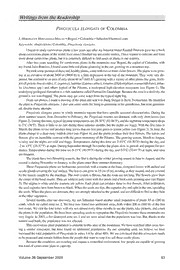
Pinguicula elongata of Colombia PDF
Preview Pinguicula elongata of Colombia
Writingsfrom the Readership PlNGUICULA ELONGATA OF COLOMBIA J. Heberleyn Hernandez-Melan • Bogota • Colombia • [email protected] Keywords: observations: Colombia, Pinguicula elongata. Ibeganto study carnivorous plants afew years ago aftermybotanistfriendRandallPetersongavemeabook aboutcarnivorousplantsoftheworld.EversinceIfinishedmyuniversitystudies,Ihavewantedtocultivateandlearn moreaboutcarnivorousplants,butitisextremelydifficulttofindseedsorplantsinourcountry. Aftertwoyears searchingforcarnivorous plantsinthemountains nearBogota, thecapitalofColombia, with myfriendJairo Ramirez.Ifoundsomelittleredplantsglisteninginthesungrowingonamountaintop. Wetooksomepicturesofthesered,healthyplants,somewithtwoorthreevioletflowers.Theplantsweregrow- m ing at anelevationofabout 3000 (9800ft) in alittle depression at the top ofthe mountain. They were very dis- persed,butconfinedtoanareaofonlyabout60 m~(645 ft )growingwithavarietyofotherplantslikegrass,fraile- jon(Espeletiabrassicoidea,E.argentea),lupinius(Lupinusalbus),romeros(Diplostephiumrosmarinifolium),pinue- las (Aechmeci spp.) and others typical ofthe Paramo, a neotropical high-elevation ecosystem (see Figure 1). The underlyinggeologicalformationisarichsandstonecalledFormacionGuadalupe.Becausetheareaisadeclivity,the groundisnotwaterlogged.Theplantsmaygetsomewaterfromthetypicalnightfog. Fromourphotos,ImadeadrawingoftheplantandsentittoJuergSteigerinBern,Switzerland. Heidentified theplantasPinguiculaelongata.IalsosentsomeseedsforJuergtogerminateinhisgreenhouse,butnonegerminat- ed,despitemanyattempts. Pinguicula elongata grows in windy mountainregions that have specific seasonal characteristics. During the short summerseason,fromDecembertoFebruary, thePinguicularosettes aredormant, withonly shortleaves (see Figure2).Duringthistime,typicaldaytimetemperaturesare28-30°C(82-86°F),andthenighttimetemperaturedrops to2°C (36°F). There islittleornorainduringthese summermonths,butthenightsarefoggy.Withthefirstrainsin March,theplantsreviveandproducelongleavesthatarcfirstpalegreentolemonyellow(seeFigure3).InJune,the plantschangeto adeeprustyreddishcolor(seeFigure 4), andtheplants producethen'firstflowers. Theleaves and flowers giveanincrediblecontrastwiththegreenmonotonyoftheParamo. Thegrowing season,MarchtoAugust, israiny andthe nights are cold andfoggy. Temperatures during this time are 5-10°C (41-50°F) during the day, and -2to+3°C (28-37°F) atnight. During SeptemberthroughNovembertheplantsslowingrowthandpreparefordor- mancy. Temperaturesduringthistimeare8-15°C(46-59°F)duringtheday, and0-5°C (32-41°F) atnight, andrains arefrequent. Theplantshavetwofloweringseasons,thefirstisduringthewintergrowingseasoninJunetoAugust,andthe secondisduringNovembertoJanuary, astheplantsentertheirsummerdormancy. ThesePinguiculaplantsarcherbaceousperennialswitharosetteatthebase,elongatedleaveswithstalkedand sessileglandscoveringtheleafsurface.Theleavescangrowto 15cm(6in),twistingastheyascend,andarecovered bytheinsectscaughtbythemucilage. Therootsystemisfibrous,buttheroots arenotlong.Theflowersgrowfrom thecenterofthebasalrosette.Theyarewhitetopalevioletwithfivepetalsandabackwardspointingspur(seeFigure 5). The stigmaiswhite andthe stamens areyellow. Eachplant canproducethreeto five flowers.Afterpollination, theseedcapsulesturnfrombrowntoblack.Whentheseedsareripe,thecapsulesdryandsplitinthesun, spreading theseeds.Whentheplantsaredormant,theyarestronglyattachedtotheground,andaredifficulttofindastheyhide intheothervegetation. Several months afterourdiscovery, my sonSebastianfoundanothersmallpopulationofplants 85 m (280ft) south, which wecalledzoneno. 2.Wehavenow foundtwo additional areas,bothwithin 200m(660ft) ofthefirst twozones.Wevisitthefourzoneswithmysonalmosteverythreemonthstoseetheplants,takepictures,andcount theplantsinthepopulation.WehavebeenspreadingseedstorepopulatethePinguiculabecausethesemountainsare veryfragile. In2003, afiredestroyedzoneno. 1 andwe were afraidthatthepopulationwas lost. But,thanks tothe naturalseedbank,thepopulationwasnotaffected. Thiscarnivorousplantpopulationisendemictothis areaofthemountains.Wehavesearchedotherareashav- ing a similar ecosystem, but have found no additional populations. By our spreading seed, we believe we have increasedthetotalpopulationofPinguiculainzones 1-4by about40%.Weareconvincedthatthisecosystemneeds tobeprotectedandremainhiddenfromthepeoplethatwanttoreapittoselltheseexoticplants. Becausetheconditions areexacting andrequireacontrolledenvironment,fewpeople arecapableofgrowing thiskindofcarnivorousplantincaptivity. Volume 38 September 2009 83 Figure 1 : Paramo community; the large plants are Espeletia sp., in theAsteraceae. Photo by Heberleyn Hernandez-Melan. Figure 2: Pinguicula elongata in its short-leaved dormancy stage to survive the dry summer. Photo by Heberleyn Hernandez-Melan. 84 Carnivorous Plant Newsletter Figure 3: A fly struggling on the leaf of Pinguicula elongata. Photo by Heberleyn Hernandez-Melan. Figure 4: Different Pinguicula elongata plants, showing a beautiful array of colors. Photo by Heberleyn Hernandez- Melan. Figure 5: A white Pinguicula elon- gata flower. The inset shows a more pink flower. The two photo- graphs are not at the same scale. Photo by Heberleyn Hernandez- Melan. Volume 38 September 2009 85
